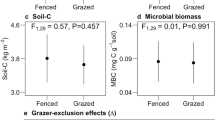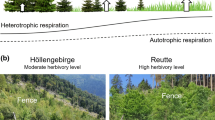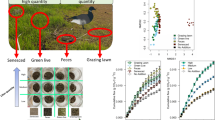Abstract
Herbivory can have strong impacts on greenhouse gas fluxes in high-latitude ecosystems. For example, in the Yukon-Kuskokwim (Y-K) Delta in western Alaska, migratory goose grazing affects the magnitude of soil carbon dioxide (CO2) and methane (CH4) fluxes. However, the underlying drivers of this relationship are unclear, as few studies systematically tease apart the processes by which herbivores influences soil biogeochemistry. To examine these mechanisms in detail, we conducted a laboratory incubation experiment to quantify changes in greenhouse gas fluxes in response to three parameters altered by herbivores in situ: temperature, soil moisture content, and nutrient inputs. These treatments were applied to soils collected in grazing lawns and nearby ungrazed habitat, allowing us to assess how variation in microbial community structure influenced observed responses. We found pronounced differences in both fungal and prokaryotic community composition between grazed and ungrazed areas. In the laboratory incubation experiment, CO2 and CH4 fluxes increased with temperature, soil moisture, and goose fecal addition, suggesting that grazing-related changes in the soil abiotic environment may enhance soil C losses. Yet, these abiotic drivers were insufficient to explain variation in fluxes between soils with and without prior grazing. Differences in trace gas fluxes between grazed and ungrazed areas may result both from herbivore-induced shifts in abiotic parameters and grazing-related alterations in microbial community structure. Our findings suggest that relationships among herbivores and soil microbial communities could mediate carbon-climate feedbacks in rapidly changing high-latitude ecosystems.




Similar content being viewed by others
References
Hugelius G, Strauss J, Zubrzycki S, Harden JW, Schuur EAG, Ping C-L, Schirrmeister L, Grosse G, Michaelson GJ, Koven CD, O’Donnell JA, Elberling B, Mishra U, Camill P, Yu Z, Palmtag J, Kuhry P (2014) Estimated stocks of circumpolar permafrost carbon with quantified uncertainty ranges and identified data gaps. Biogeosciences (Online) 11(23):6573–6593. https://doi.org/10.5194/bg-11-6573-2014
Panikov NS (1999) Fluxes of CO2 and CH4 in high latitude wetlands: measuring, modelling and predicting response to climate change. Polar Res 18(2):237–244. https://doi.org/10.1111/j.1751-8369.1999.tb00299.x
Hobbie SE, Schimel JP, Trumbore SE, Randerson JR (2000) Controls over carbon storage and turnover in high-latitude soils. Glob Chang Biol 6(S1):196–210. https://doi.org/10.1046/j.1365-2486.2000.06021.x
Ruess RW, Uliassi DD, Mulder CPH, Person BT (1997) Growth responses of Carex ramenskii to defoliation, salinity, and nitrogen availability: implications for geese-ecosystem dynamics in western Alaska. Ecoscience 4(2):170–178. https://doi.org/10.1080/11956860.1997.11682392
Kelsey KC, Leffler AJ, Beard KH, Schmutz JA, Choi RT, Welker JM (2016) Interactions among vegetation, climate, and herbivory control greenhouse gas fluxes in a subarctic coastal wetland. J Geophys Res Biogeosci 121(12):2960–2975. https://doi.org/10.1002/2016JG003546
Asner GP, Elmore AJ, Olander LP, Martin RE, Harris AT (2004) Grazing systems, ecosystem responses, and global change. Annu Rev Environ Resour 29(1):261–299. https://doi.org/10.1146/annurev.energy.29.062403.102142
van der Wal R, Brooker RW (2004) Mosses mediate grazer impacts on grass abundance in arctic ecosystems. Funct Ecol 18(1):77–86. https://doi.org/10.1111/j.1365-2435.2004.00820.x
Beard KH, Kelsey KC, Leffler AJ, Welker JM (2019) The missing angle: ecosystem consequences of phenological mismatch. Trends Ecol Evol 34(10):885–888. https://doi.org/10.1016/j.tree.2019.07.019
Bardgett RD, Wardle DA, Yeates GW (1998) Linking above-ground and below-ground interactions: how plant responses to foliar herbivory influence soil organisms. Soil Biol Biochem 30(14):1867–1878. https://doi.org/10.1016/S0038-0717(98)00069-8
Hamilton EW, Frank DA (2001) Can plants stimulate soil microbes and their own nutrient supply? Evidence from a grazing tolerant grass. Ecology 82(9):2397–2402. https://doi.org/10.2307/2679923
Hik DS, Jefferies RL (1990) Increases in the net above-ground primary production of a salt-marsh forage grass: a test of the predictions of the herbivore optimization model. J Ecol 78(1):180–195. https://doi.org/10.2307/2261044
Sjögersten S, van der Wal R, Woodin SJ (2008) Habitat type determines herbivory controls over CO2 fluxes in a warmer Arctic. Ecology 89(8):2103–2116. https://doi.org/10.1890/07-1601.1
Falk JM, Schmidt NM, Christensen TR, Ström L (2015) Large herbivore grazing affects the vegetation structure and greenhouse gas balance in a high arctic mire. Environ Res Lett 10(4):045001. https://doi.org/10.1088/1748-9326/10/4/045001
Chalmandrier L, Pansu J, Zinger L, Boyer F, Coissac E, Génin A, Gielly L, Lavergne S, Legay N, Schilling V, Taberlet P, Münkemüller T, Thuiller W (2019) Environmental and biotic drivers of soil microbial β-diversity across spatial and phylogenetic scales. Ecography 42(12):2144–2156. https://doi.org/10.1111/ecog.04492
Schimel J, Schaeffer SM (2012) Microbial control over carbon cycling in soil. Front Microbiol 3. https://doi.org/10.3389/fmicb.2012.00348
Glassman SI, Weihe C, Li J, Albright MBN, Looby CI, Martiny AC, Treseder KK, Allison SD, Martiny JBH (2018) Decomposition responses to climate depend on microbial community composition. Proc Natl Acad Sci 115(47):11994–11999. https://doi.org/10.1073/pnas.1811269115
Melillo JM, Frey SD, DeAngelis KM, Werner WJ, Bernard MJ, Bowles FP, Pold G, Knorr MA, Grandy AS (2017) Long-term pattern and magnitude of soil carbon feedback to the climate system in a warming world. Science 358(6359):101–105. https://doi.org/10.1126/science.aan2874
Bradford MA, Davies CA, Frey SD, Maddox TR, Melillo JM, Mohan JE, Reynolds JF, Treseder KK, Wallenstein MD (2008) Thermal adaptation of soil microbial respiration to elevated temperature. Ecol Lett 11(12):1316–1327. https://doi.org/10.1111/j.1461-0248.2008.01251.x
Sjögersten S, van der Wal R, Loonen MJJE, Woodin SJ (2011) Recovery of ecosystem carbon fluxes and storage from herbivory. Biogeochemistry 106(3):357–370. https://doi.org/10.1007/s10533-010-9516-4
Buckeridge KM, Jefferies RL (2007) Vegetation loss alters soil nitrogen dynamics in an Arctic salt marsh. J Ecol 95(2):283–293. https://doi.org/10.1111/j.1365-2745.2007.01214.x
Leffler AJ, Beard KH, Kelsey KC, Choi RT, Schmutz JA, Welker JM (2019) Delayed herbivory by migratory geese increases summer-long CO2 uptake in coastal western Alaska. Glob Chang Biol 25(1):277–289. https://doi.org/10.1111/gcb.14473
Tande GF, Jennings TW (1986) Classification and mapping of tundra near Hazen Bay, Yukon Delta National Wildlife Refuge, Alaska. Available from the Alaska Investigations Field Office. U.S. Fish and Wildlife Service, Anchorage
Person BT, Babcock CA, Ruess RW (1998) Forage variation in brood-rearing areas used by pacific black brant geese on the Yukon-Kuskokwim delta, Alaska. J Ecol 86(2):243–259. https://doi.org/10.1046/j.1365-2745.1998.00249.x
Uher-Koch BD, Schmutz JA, Wilson HM, Anthony RM, Day TL, Fondell TF, Person BT, Sedinger JS (2019) Ecosystem-scale loss of grazing habitat impacted by abundance of dominant herbivores. Ecosphere 10(6):e02767. https://doi.org/10.1002/ecs2.2767
Booth DT, Cox SE, Berryman RD (2006) Point sampling digital imagery with ‘Samplepoint’. Environ Monit Assess 123(1–3):97–108. https://doi.org/10.1007/s10661-005-9164-7
Caporaso JG, Lauber CL, Walters WA, Berg-Lyons D, Lozupone CA, Turnbaugh PJ, Fierer N, Knight R (2011) Global patterns of 16S rRNA diversity at a depth of millions of sequences per sample. Proc Natl Acad Sci 108(Supplement 1):4516–4522. https://doi.org/10.1073/pnas.1000080107
Caporaso JG, Lauber CL, Walters WA, Berg-Lyons D, Huntley J, Fierer N, Owens SM, Betley J, Fraser L, Bauer M, Gormley N, Gilbert JA, Smith G, Knight R (2012) Ultra-high-throughput microbial community analysis on the Illumina HiSeq and MiSeq platforms. ISME J 6(8):1621–1624. https://doi.org/10.1038/ismej.2012.8
Bokulich NA, Mills DA (2013) Improved selection of internal transcribed spacer-specific primers enables quantitative, ultra-high-throughput profiling of fungal communities. Appl Environ Microbiol 79(8):2519–2526. https://doi.org/10.1128/AEM.03870-12
Bolyen E, Rideout JR, Dillon MR, Bokulich NA, Abnet CC, Al-Ghalith GA, Alexander H, Alm EJ, Arumugam M, Asnicar F, Bai Y, Bisanz JE, Bittinger K, Brejnrod A, Brislawn CJ, Brown CT, Callahan BJ, Caraballo-Rodríguez AM, Chase J, … Caporaso JG (2019) Reproducible, interactive, scalable and extensible microbiome data science using QIIME 2. Nat Biotechnol 37(8):852–857. https://doi.org/10.1038/s41587-019-0209-9
Callahan BJ, McMurdie PJ, Rosen MJ, Han AW, Johnson AJA, Holmes SP (2016) DADA2: high-resolution sample inference from Illumina amplicon data. Nat Methods 13(7):581–583. https://doi.org/10.1038/nmeth.3869
DeSantis TZ, Hugenholtz P, Larsen N, Rojas M, Brodie EL, Keller K, Huber T, Dalevi D, Hu P, Andersen GL (2006) Greengenes, a chimera-checked 16S rRNA gene database and workbench compatible with ARB. Appl Environ Microbiol 72(7):5069–5072. https://doi.org/10.1128/AEM.03006-05
Camacho C, Coulouris G, Avagyan V, Ma N, Papadopoulos J, Bealer K, Madden TL (2009) BLAST+: architecture and applications. BMC Bioinform 10(1):421. https://doi.org/10.1186/1471-2105-10-421
Nilsson RH, Larsson K-H, Taylor AFS, Bengtsson-Palme J, Jeppesen TS, Schigel D, Kennedy P, Picard K, Glöckner FO, Tedersoo L, Saar I, Kõljalg U, Abarenkov K (2019) The UNITE database for molecular identification of fungi: Handling dark taxa and parallel taxonomic classifications. Nucleic Acids Res 47(D1):D259–D264. https://doi.org/10.1093/nar/gky1022
Beard KH, Choi RT (2017) Asynchrony in the timing of goose-vegetation interactions: implications for biogeochemical cycling in wet sedge tundra Tutakoke River, Yukon Delta NWR, Alaska, 2014-2016. Arctic Data Center. https://doi.org/10.18739/A22274
Vance ED, Brookes PC, Jenkinson DS (1987) An extraction method for measuring soil microbial biomass C. Soil Biol Biochem 19(6):703–707. https://doi.org/10.1016/0038-0717(87)90052-6
Oksanen JF, Blanchet G, Friendly M, Kindt R, Legendre P, McGlinn D, Minchin PR, O'Hara RB, Simpson GL, Solymos P, Stevens MHH, Szoecs E, Wagner H (2019) vegan: community ecology package. R Package Version 2:5–4 https://CRAN.Rproject.org/package=vegan
Mandal S, Treuren WV, White RA, Eggesbø M, Knight R, Peddada SD (2015) Analysis of composition of microbiomes: a novel method for studying microbial composition. Microb Ecol Health Dis 26(1):27663. https://doi.org/10.3402/mehd.v26.27663
Bates D, Maechler M, Bolker B, Walker S (2015) Fitting linear mixed-effects models using lme4. J Stat Softw 67(1):1–48. https://doi.org/10.18637/jss.v067.i01
Kuznetsova A, Brockhoff PB, Christensen RHB (2017) lmerTest package: tests in linear mixed effects models. J Stat Softw 82(13):1–26. https://doi.org/10.18637/jss.v082.i13
Hothorn T, Bretz F, Westfall P (2008) Simultaneous inference in general parametric models. Biometrical Journal Biometrische Zeitschrift 50(3):346–363. https://doi.org/10.1002/bimj.200810425
Choi RT, Beard KH, Leffler AJ, Kelsey KC, Schmutz JA, Welker JM (2019) Phenological mismatch between season advancement and migration timing alters Arctic plant traits. J Ecol 107(5):2503–2518. https://doi.org/10.1111/1365-2745.13191
Stark S, Grellmann D (2002) Soil microbial responses to herbivory in an Arctic tundra heath at two levels of nutrient availability. Ecology 83(10):2736–2744. https://doi.org/10.1890/0012-9658(2002)083[2736:SMRTHI]2.0.CO;2
Grosse G, Harden J, Turetsky M, McGuire AD, Camill P, Tarnocai C, Frolking S, Schuur EAG, Jorgenson T, Marchenko S, Romanovsky V, Wickland KP, French N, Waldrop M, Bourgeau-Chavez L, Striegl RG (2011) Vulnerability of high-latitude soil organic carbon in North America to disturbance. J Geophys Res Biogeosci 116(G4). https://doi.org/10.1029/2010JG001507
Otero XL, De La Peña-Lastra S, Pérez-Alberti A, Ferreira TO, Huerta-Diaz MA (2018) Seabird colonies as important global drivers in the nitrogen and phosphorus cycles. Nat Commun 9(1):246. https://doi.org/10.1038/s41467-017-02446-8
Fierer N, Bradford MA, Jackson RB (2007) Toward an ecological classification of soil bacteria. Ecology 88(6):1354–1364. https://doi.org/10.1890/05-1839
Davidson EA, Janssens IA (2006) Temperature sensitivity of soil carbon decomposition and feedbacks to climate change. Nature 440(7081):165–173. https://doi.org/10.1038/nature04514
Creamer CA, de Menezes AB, Krull ES, Sanderman J, Newton-Walters R, Farrell M (2015) Microbial community structure mediates response of soil C decomposition to litter addition and warming. Soil Biol Biochem 80:175–188. https://doi.org/10.1016/j.soilbio.2014.10.008
NOAA. (2019). Arctic report card: record territory for warm temperatures, loss of snow, and ice. Accessed: https://www.noaa.gov/media-release/arctic-report-card-record-territory-for-warm-temperatures-loss-of-snow-and-ice
Lohman MG, Riecke TV, Acevedo CR, Person BT, Schmutz JA, Uher-Koch BD, Sedinger JS (2019) Changes in behavior are unable to disrupt a trophic cascade involving a specialist herbivore and its food plant. Ecol Evol 9(9):5281–5291. https://doi.org/10.1002/ece3.5118
Tape KD, Flint PL, Meixell BW, Gaglioti BV (2013) Inundation, sedimentation, and subsidence creates goose habitat along the Arctic coast of Alaska. Environ Res Lett 8(4):045031. https://doi.org/10.1088/1748-9326/8/4/045031
Flint PL, Meixell BW, Mallek EJ (2014) High fidelity does not preclude colonization: range expansion of molting black brant on the Arctic coast of Alaska. J Field Ornithol 85(1):75–83. https://doi.org/10.1111/jofo.12051
Fischer JB, Williams AR, Stehn RA (2017) Nest population size and potential production of geese and spectacled eiders on the Yukon-Kuskokwim Delta, Alaska, 1985-2016. Unpubl. Rep, U.S. Fish and Wildlife Service, Anchorage
Campbell EE, Paustian K (2015) Current developments in soil organic matter modeling and the expansion of model applications: a review. Environ Res Lett 10(12):123004. https://doi.org/10.1088/1748-9326/10/12/123004
Acknowledgements
We thank M. Lindberg and his crew for logistical support during field collection of samples, R. Choi for advice on study site locations and plant identification, and the Yukon-Kuskokwim Delta National Wildlife Refuge for allowing us to collect soil samples.
Availability of data and materials
Upon acceptance of the manuscript for publication, all data will be archived in Dryad digital repository (www.datadryad.org).
Funding
The work was funded by the National Science Foundation awards ARC-1304523 and ARCCS-1932889, a Utah State University (USU) Research Catalyst grant, a USU Research and Graduate Studies Dissertation Enhancement, and the Utah Agricultural Experiment Station, approved as journal paper 9298.
Author information
Authors and Affiliations
Contributions
All authors designed the study; KF, BW, and KB collected samples and data in the field; KF performed sample processing and laboratory analyses; KF, BW, and TA performed statistical analyses of output data and all authors reviewed analyses for accuracy; KB arranged funding for the research; KF wrote the initial draft of the manuscript, and all authors contributed substantially to revisions.
Corresponding author
Ethics declarations
Ethics approval and consent to participate
Not applicable
Consent to participate
Not applicable
Consent for publication
Not applicable
Conflicts of interest
None to declare
Supplementary information
ESM 1
(DOCX 1815 kb)
Rights and permissions
About this article
Cite this article
Foley, K.M., Beard, K.H., Atwood, T.B. et al. Herbivory changes soil microbial communities and greenhouse gas fluxes in a high-latitude wetland. Microb Ecol 83, 127–136 (2022). https://doi.org/10.1007/s00248-021-01733-8
Received:
Accepted:
Published:
Issue Date:
DOI: https://doi.org/10.1007/s00248-021-01733-8




